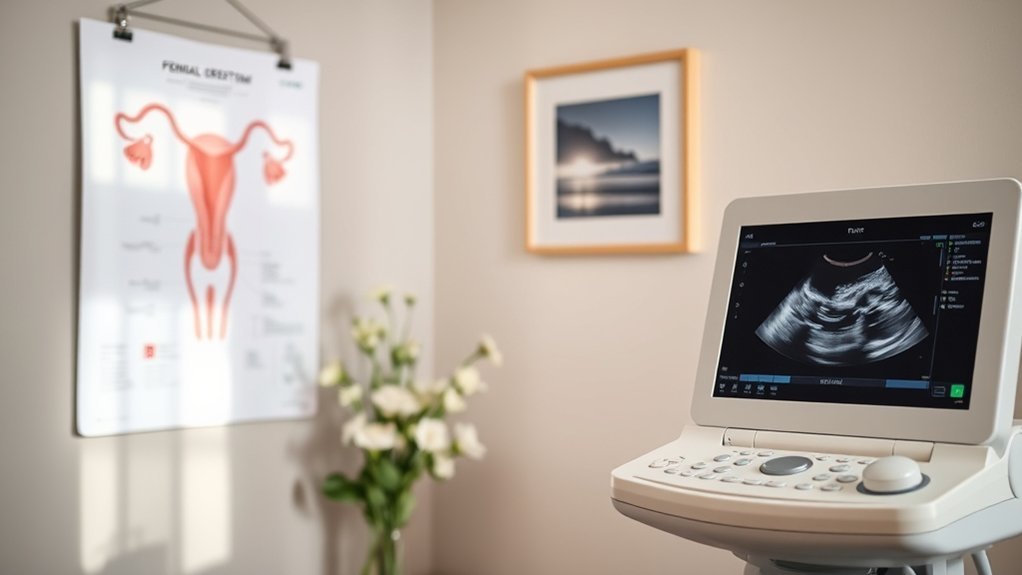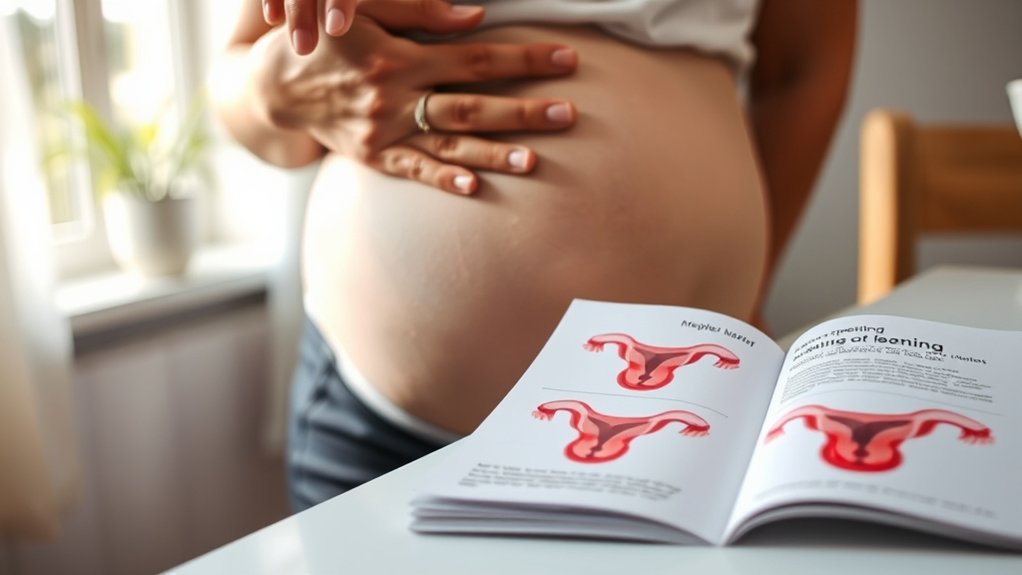In the early stages of pregnancy, spotting can feel like a sudden storm on a clear day. It’s a common concern that many expectant mothers face, often leading to anxiety and uncertainty. Understanding what spotting means, its causes, and when to seek help can provide clarity. As you navigate this experience, it’s essential to distinguish between normal occurrences and potential issues that may arise. Let’s explore these important aspects together.
What Is Spotting and How Common Is It in Early Pregnancy?

Spotting refers to light vaginal bleeding that can occur during early pregnancy, and it’s quite common. Many women experience this phenomenon, often during the first trimester, and it can range from a few drops to a light flow.
While it might seem alarming, it’s important to know that spotting doesn’t always indicate a problem. In fact, many women go on to have healthy pregnancies despite experiencing spotting. This occurrence can be a normal part of your body adjusting to pregnancy hormones.
If you notice spotting, pay attention to its color and duration, and don’t hesitate to reach out to your healthcare provider for confirmation. They can provide guidance and guarantee everything’s progressing as it should.
What Are the Possible Causes of Spotting in the First Trimester?

While experiencing spotting in the first trimester can be concerning, it’s essential to understand that various factors could be at play.
Implantation bleeding often occurs when the fertilized egg attaches to your uterine lining, causing light spotting. Hormonal changes can also lead to spotting, especially as your body adjusts to the pregnancy.
Cervical changes, such as increased blood flow or sensitivity, might contribute to light bleeding, particularly after intercourse. Additionally, conditions like a subchorionic hemorrhage, which is a small collection of blood, can cause spotting without posing significant risk.
How Does Spotting Differ From Heavy Bleeding?

Understanding the distinction between spotting and heavy bleeding can help alleviate anxiety during early pregnancy.
Spotting typically presents as light, infrequent bleeding, often brown or pink in color, and may occur during activities like sexual intercourse or as a result of hormonal changes. It’s usually minimal, requiring only a panty liner.
In contrast, heavy bleeding involves a more substantial flow, often red in color, and may include clots. You might need to change your pad or tampon frequently within a few hours.
Heavy bleeding can also be accompanied by symptoms like cramping or pain. Recognizing these differences can empower you to monitor your symptoms and make informed decisions about your health during this critical time.
When Should You Seek Medical Attention for Spotting?
If you experience spotting during early pregnancy, it’s important to know when to seek medical attention.
Generally, you should reach out to your healthcare provider if the spotting is accompanied by severe cramping, heavy bleeding, or tissue passing from the vagina.
Additionally, if the spotting persists or changes in color or consistency, don’t hesitate to call your doctor.
If spotting continues or alters in color or texture, reach out to your doctor without delay.
Fever, chills, or unusual pain can also indicate a need for immediate medical evaluation.
Trust your instincts; if something feels off, it’s better to err on the side of caution.
Remember, timely communication with your healthcare team can provide reassurance and promote your well-being during this critical time.
Always prioritize your health and safety.
Can Spotting Indicate a Miscarriage?
Can spotting during the first trimester signal a miscarriage? While it can be concerning, not all spotting indicates a miscarriage. Many women experience light spotting without complications. Understanding the context is essential.
| Possible Causes | Emotional Impact |
|---|---|
| Healthy implantation | Hope and reassurance |
| Hormonal changes | Normalcy and calm |
| Miscarriage | Anxiety and fear |
If you experience spotting, consider factors like color, amount, and duration. Bright red blood, heavy flow, or cramping can warrant closer attention. Remember, many pregnancies progress despite spotting. If you’re worried, consult your healthcare provider for guidance and peace of mind. Knowledge is empowering, so don’t hesitate to seek support.
What Steps Can You Take If You Experience Spotting?
If you experience spotting during the first trimester, it’s essential to contact your healthcare provider promptly.
They can assess your situation and provide guidance tailored to your needs.
Additionally, monitor any accompanying symptoms closely, as this information can be significant for your care.
Contact Your Healthcare Provider
Experiencing spotting during the first trimester can understandably raise concerns, making it vital to take prompt action.
Contact your healthcare provider to guarantee your health and the well-being of your pregnancy. Here’s what you should do:
- Document the spotting: Note the color, amount, and frequency.
- Monitor accompanying symptoms: Be aware of any pain, cramping, or unusual discharge.
- Avoid self-diagnosing: Rely on your healthcare professional for accurate assessments.
- Prepare questions: Write down any concerns or queries you have before your appointment.
- Follow their guidance: Adhere to any recommendations or tests your provider suggests.
Taking these steps can provide you with reassurance and clarity during this pivotal time.
Monitor Symptoms Closely
Understanding the importance of monitoring your symptoms closely is essential when you experience spotting in the first trimester. Keep a detailed record of the spotting, noting its color, consistency, and duration.
Pay attention to any accompanying symptoms, such as cramping, pain, or changes in discharge. If you notice a significant increase in bleeding or severe pain, seek medical attention promptly.
It’s also helpful to track your emotional well-being, as anxiety is common during this time. Regularly check in with your healthcare provider about your symptoms, even if they seem minor.
How Can You Differentiate Between Normal Spotting and Potential Issues?
While some spotting in the first trimester can be perfectly normal, it’s essential to recognize when it may signal potential issues.
Some spotting in early pregnancy is normal, but it’s crucial to identify when it may indicate a problem.
Pay attention to the following signs that could indicate a problem:
- Bright red blood, especially if it’s heavy
- Spotting accompanied by severe cramping or pain
- Tissue or clots passing along with the bleeding
- Symptoms of faintness or dizziness
- Persistent spotting that lasts more than a few days
If you notice any of these signs, don’t hesitate to contact your healthcare provider. They can offer guidance and peace of mind.
Frequently Asked Questions
Can Stress or Anxiety Cause Spotting in Early Pregnancy?
Stress and anxiety can contribute to hormonal changes that might lead to spotting in early pregnancy. It’s important to manage stress and consult your healthcare provider for reassurance and guidance on your specific situation.
Does the Color of the Spotting Matter?
Yes, the color of spotting can matter. Red often indicates fresh blood, while brown may suggest older blood. However, it’s essential to monitor other symptoms and consult a healthcare provider for personalized advice.
Is It Safe to Exercise With Spotting?
It’s generally safe to exercise with light spotting, but listen to your body. If you experience pain or heavy bleeding, stop exercising and consult your healthcare provider for personalized advice tailored to your situation.
Can Certain Medications Lead to Spotting?
Yes, certain medications can lead to spotting. If you’re experiencing this side effect, it’s crucial to consult your healthcare provider. They can review your medications and guarantee everything’s safe for your health and pregnancy.
How Long Does Spotting Typically Last During the First Trimester?
Spotting during the first trimester typically lasts a few hours to a couple of days. While it’s often normal, you should consult your healthcare provider if it persists or worsens, ensuring your peace of mind.
Conclusion
In summary, while spotting in the first trimester can be common and often harmless, it’s important to stay vigilant. Think of your body as a delicate garden; a little change in color can signify growth or a need for attention. If you experience spotting, especially with severe cramps or heavy bleeding, don’t hesitate to reach out to your healthcare provider. Trust your instincts and prioritize your health, as it’s always better to be safe than sorry during this vital time.
